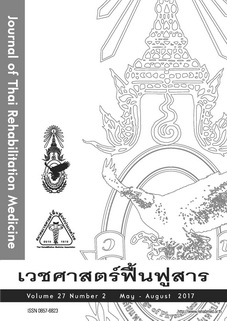เปรียบเทียบผลการตอบสนองต่อการออกกำลังด้วยการเดินสายพานโดยฟังเพลงไทยและไม่ฟังเพลงในประชากรที่ไม่ได้ออกกำลังกายเป็นประจำ
เปรียบเทียบผลการตอบสนองต่อการออกกำลังด้วยการเดินสายพานโดยฟังเพลงไทยและไม่ฟังเพลงในประชากรที่ไม่ได้ออกกำลังกายเป็นประจำ
Keywords:
Thai style music, exercise, treadmillAbstract
Objectives: To compare perceived exertion and physiological responses during treadmill walking between listening to Thai music and no music in untrained adults.
Study design: Assessor blinded, crossover, randomized control trial.
Setting: Department of Rehabilitation Medicine, King Chulalongkorn Memorial Hospital
Subjects: Untrained healthy volunteers aged 18-59 years
Methods: Participants were assessed baseline data (age, weight, height, heart rate, blood pressure) then randomized into 2 groups. First group listen to Thai contemporary music selected from four types of music (Thai pop, Looktung, Lookkrung and Peuchevit) while performing treadmill exercise at 60% HRmax for 20 minutes, washout 1 week then performed treadmill exercise again without listening to music. Second group the order was reversed. RPE, SBP, maximum speed, total distant and enjoyment VAS were recorded for each exercise session.
Results: 30 volunteers, 13 males and 17 females were recruited. 2 males dropped out, one from each group. Mean RPE was significantly lower listening to music (11.29) comparing with no music (12.37, p < 0.001). Mean enjoyment VAS was significantly greater while listening to music (6.92) comparing with no music (4.37, p<0.001). No statistically significant difference regarding SBP, speed and total distant.
Conclusion: Music can decrease RPE and increase enjoyment during treadmill exercise at fixed work load.
References
เอกสารอ้างอิง
Kravitz L. The effects of music on exercise. IDEA Today. 1994;12(9):56-61.
Ruscello B, D'Ottavio S, Padua E, Tonelli C, Pantanella L. The influence of music on exercise in a group of sedentary elderly women: an important tool to help the elderly to stay active. The Journal of sports medicine and physical fitness. 2014 Aug;54(4):536-44. PubMed PMID: 25034556. Epub 2014/07/19. eng.
Baldari C, Macone D, Bonavolonta V, Guidetti L. Effects of music during exercise in different training status. The Journal of sports medicine and physical fitness. 2010 Sep;50(3):281-7. PubMed PMID: 20842088. Epub 2010/09/16. eng.
Harmon NMK, L. The effects of music on exercise. IDEA Fitness Journal. 2007;4(8):72-7.
Karageorghis C, Jones L, Stuart DP. Psychological effects of music tempi during exercise. International journal of sports medicine. 2008 Jul;29(7):613-9. PubMed PMID: 18050063. Epub 2007/12/01. eng.
Szmedra L DWB. Effect of music on perceived exertion, plasma lactate, norepinephrine and cardiovascular hemodynamics during treadmill running. International journal of sports medicine. 1998;19:32-7.
Styns F, van Noorden L, Moelants D, Leman M. Walking on music. Human Movement Science. 2007 10//;26(5):769-85.
Yamashita S, Iwai K, Akimoto T, Sugawara J, Kono I. Effects of music during exercise on RPE, heart rate and the autonomic nervous system. The Journal of sports medicine and physical fitness. 2006 Sep;46(3):425-30. PubMed PMID: 16998447. Epub 2006/09/26. eng.
Copeland BL, Franks BD. Effects of types and intensities of background music on treadmill endurance. The Journal of sports medicine and physical fitness. 1991 Mar;31(1):100-3. PubMed PMID: 1861474. Epub 1991/03/01. eng.
Edworthy J, Waring H. The effects of music tempo and loudness level on treadmill exercise. Ergonomics. 2006 2006/12/15;49(15):1597-610.
Thakur AM, Yardi SS. Effect of different types of music on exercise performance in normal individuals. Indian journal of physiology and pharmacology. 2013 Oct-Dec;57(4):448-51. PubMed PMID: 24968586. Epub 2014/06/28. eng.
Waringa JEH. The effects of music tempo and loudness level on treadmill exercise. Ergonomics 2006 Volume 49(Issue 15).
Knight WEJ, Rickard NS. Relaxing Music Prevents Stress-Induced Increases in Subjective Anxiety, Systolic Blood Pressure, and Heart Rate in Healthy Males and Females. Journal of music therapy. 2001 December 21, 2001;38(4):254-72.
Landreth JE, Landreth HF. Effects of Music on Physiological Response. Journal of Research in Music Education. 1974;22(1):4-12.
Tan F, Tengah A, Nee LY, Fredericks S. A study of the effect of relaxing music on heart rate recovery after exercise among healthy students. Complementary Therapies in Clinical Practice. 2014 5//;20(2):114-7.
Brownley KA, McMurray RG, Hackney AC. Effects of music on physiological and affective responses to graded treadmill exercise in trained and untrained runners. International journal of psychophysiology : official journal of the International Organization of Psychophysiology. 1995 Apr;19(3):193-201. PubMed PMID: 7558986. Epub 1995/04/01. eng.
Da Silva AG, Guida HL, Antonio AM, Marcomini RS, Fontes AM, Carlos de Abreu L, et al. An exploration of heart rate response to differing music rhythm and tempos. Complement Ther Clin Pract. 2014 May;20(2):130-4. PubMed PMID: 24767959. Epub 2014/04/29. eng.
Karageorghis CI, Jones L, Low DC. Relationship between exercise heart rate and music tempo preference. Research quarterly for exercise and sport. 2006 Jun;77(2):240-50. PubMed PMID: 16898279. Epub 2006/08/11. eng.
Dyrlund AK, Wininger SR. The effects of music preference and exercise intensity on psychological variables. Journal of music therapy. 2008 Summer;45(2):114-34. PubMed PMID: 18563969. Epub 2008/06/20. eng.
Leman M, Moelants D, Varewyck M, Styns F, van Noorden L, Martens JP. Activating and relaxing music entrains the speed of beat synchronized walking. PloS one. 2013;8(7):e67932. PubMed PMID: 23874469. Pubmed Central PMCID: PMC3707869. Epub 2013/07/23. eng.
Alter DA, O'Sullivan M, Oh PI, Redelmeier DA, Marzolini S, Liu R, et al. Synchronized personalized music audio-playlists to improve adherence to physical activity among patients participating in a structured exercise program: a proof-of-principle feasibility study. Sports medicine - open. 2015;1(1):7. PubMed PMID: 26284164. Pubmed Central PMCID: PMC4532714. Epub 2015/08/19. eng.






